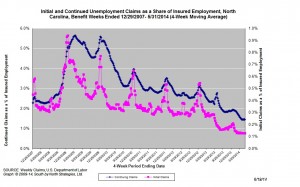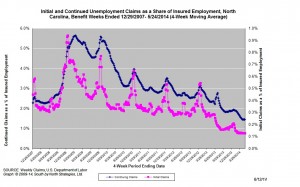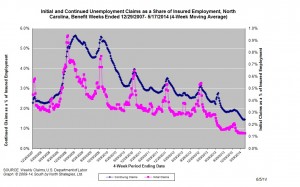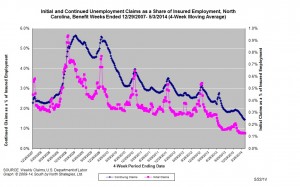NC Unemployment Claims: Week Of 5/31/14
For the benefit week ending on May 31, 2014, North Carolinians filed some 5,663 initial claims for state unemployment insurance benefits and 52,378 claims for state-funded continuing benefits. Compared to the prior week, there were more initial claims and fewer continuing claims. These figures come from data released by the US Department of Labor.
Averaging new and continuing claims over a four-week period — a process that helps adjust for seasonal fluctuations and better illustrates trends — shows that an average of 5,456 initial claims were filed over the previous four weeks, along with an average of 53,138 continuing claims. Compared to the previous four-week period, the average number of initial claims was higher, and the average number of continuing claims was lower.
One year ago, the four-week average for initial claims stood at 10,826, and the four-week average of continuing claims equaled 89,734.
In recent months covered employment has increased and now exceeds the level recorded a year ago (3.89 million versus 3.82 million). Nevertheless, there are still fewer covered workers than there were in January 2008, which means that payrolls are smaller today than they were more than six years ago.
The graph (below right) shows the changes in unemployment insurance claims measured as a share of covered employment in North Carolina since the recession’s start in December 2007.
Both new and continuing claims have peaked for this cycle, and the four-week averages of new and continuing claims have fallen considerably. The four-week average of initial claims, when measured as a share of covered employment, is at the lowest level recorded since early 2008, while the four-week average of continuing claims also is at the lowest level recorded since early 2008.
Note that the recent declines in new and continuing claims are not necessarily indicative of an improving labor market. State legislation that took effect on July 1, 2013, made major changes to insurance eligibility criteria, and the more stringent criteria eliminate claims that would have been valid prior to July 1. Additionally, the legislation reduced the maximum number of weeks of state-funded insurance for which a claimant is eligible — an action that eventually should lead to a reduction in the number of continuing claims.
To place the numbers in context, consider how the four-week average of initial claims (5,456) was 49.6 percent lower than the figure recorded one year ago (10,826), while the average number of continuing claims was 40.8 percent lower (53,138 versus 89,734). Given the modest rate of job growth that has occurred in North Carolina over the past year, such declines likely are products of changes to unemployment insurance laws rather than improvements in underlying economic conditions.
NC Unemployment Claims: Week Of 5/24/14
For the benefit week ending on May 24, 2014, North Carolinians filed some 4,622 initial claims for state unemployment insurance benefits and 53,067 claims for state-funded continuing benefits. Compared to the prior week, there were fewer initial claims and more continuing claims. These figures come from data released by the US Department of Labor.
Averaging new and continuing claims over a four-week period — a process that helps adjust for seasonal fluctuations and better illustrates trends — shows that an average of 5,375 initial claims were filed over the previous four weeks, along with an average of 53,522 continuing claims. Compared to the previous four-week period, the average number of initial claims was higher, and the average number of continuing claims was lower.
One year ago, the four-week average for initial claims stood at 10,754, and the four-week average of continuing claims equaled 89,252.
In recent months covered employment has increased and now exceeds the level recorded a year ago (3.89 million versus 3.82 million). Nevertheless, there are still fewer covered workers than there were in January 2008, which means that payrolls are smaller today than they were more than six years ago.
The graph (below right) shows the changes in unemployment insurance claims measured as a share of covered employment in North Carolina since the recession’s start in December 2007.
Both new and continuing claims have peaked for this cycle, and the four-week averages of new and continuing claims have fallen considerably. The four-week average of initial claims, when measured as a share of covered employment, is at the lowest level recorded since early 2008, while the four-week average of continuing claims also is at the lowest level recorded since early 2008.
Note that the recent declines in new and continuing claims are not necessarily indicative of an improving labor market. State legislation that took effect on July 1, 2013, made major changes to insurance eligibility criteria, and the more stringent criteria eliminate claims that would have been valid prior to July 1. In time, this development also should reduce the number of continuing claims. Additionally, the legislation reduced the maximum number of weeks of state-funded insurance for which a claimant is eligible — an action that eventually should lead to a reduction in the number of continuing claims.
To place the numbers in context, consider how the four-week average of initial claims (4,622) was 57 percent lower than the figure recorded one year ago (10,754), while the average number of continuing claims was 40.5 percent lower (53,067 versus 89,252). Given the modest rate of job growth that has occurred in North Carolina over the past year, such declines likely are products of changes to unemployment insurance laws rather than improvements in underlying economic conditions.
US Labor Market Drifts Through May
CHAPEL HILL, NC (June 6, 2014) – In May, the national labor market added 217,000 more jobs than it lost due almost entirely to gains in the private sector. The net job gain, however, did not translate into a reduction in the national unemployment rate, which held steady at 6.3 percent. The unchanged unemployment rate was attributable in large part to a sharp drop in the labor force participation rate that occurred in April and that was not reversed in May.
“May was the 44th-straight month in which the United States experienced net job growth,” said John Quinterno, a principal with South by North Strategies, Ltd., a research firm specializing in economic and social policy. “Over the year, the economy has netted an average of 198,000 jobs per month, but that pace of growth is insufficient to replace all of the jobs lost since 2007 and to accommodate subsequent population growth.”
In May, the nation’s employers added 217,000 more payroll jobs than they cut. Virtually all of the gain originated in the private sector (+216,000), while public employers added 1,000 more positions than they cut. Within the private sector, payroll levels rose the most in the education and health services sector (+63,000, with 53.3 percent of the gain occurring in the health care subsector), followed by the professional business services sector (+55,000, with 50.7 percent of the gain occurring in the administrative and waste services subsector), the leisure and hospitality services sector (+39,000, with 88.2 percent of the gain originating in the accommodation and food service sector), and the trade, transportation, and utilities sector (+39,000, with 32.1 percent of the gain occurring in the retail trade subsector). Payroll levels in the other major industry groups rose slightly or essentially held steady.
Additionally, the payroll employment numbers for March and April underwent revisions; with the updates, the economy netted 485,000 jobs over those two months, not the 491,000 positions previously reported. With those changes, the average pace of monthly job growth in the United States recorded over the past year dipped to 198,000 from 199,000.
“While the United States has experienced steady job growth for the past 3.5 years, the pace of growth has been modest relative to the severity of the job losses caused by the last recession,” noted Quinterno. “The current average monthly rate of job growth is insufficient to close the nation’s jobs gap anytime soon. And the overall pace of job growth appears to be inconsistent with the weak macroeconomic conditions that marked 2014’s first quarter.”
Data from the household survey offered some positive news about the state of the United States’ labor market. In May, the number of Americans who reported having jobs rose by 145,000 (+0.1 percent); put differently, slightly more people reported having jobs in May than in April. At the same time, the overall size of the labor force rose by 192,000 persons (+0.1 percent) between April and May. Yet in April, the share of working-age Americans participating in the labor force fell sharply, with the rate remaining unchanged in May. Similarly, the share of working-age Americans with a job has not changed since March.
In May, 9.8 million Americans were unemployed (6.3 percent), while 7.3 million individuals worked part time despite preferring full-time positions. Another 697,000 individuals (not seasonally adjusted) were so discouraged about their job prospects that they had stopped searching for work altogether. Those persons were part of a larger population of 2.1 million Americans who were marginally attached to the labor force.
Compared to a year ago, 1.9 million more Americans were working in May, and 1.9 million fewer persons were unemployed. At the same time, the share of the working-age population with a job (58.9 percent) remained at a depressed level, while the share of the population that was participating in the labor force actually decreased over the year, falling to 62.8 percent from 63.4 percent.
Last month, the unemployment rate was higher among adult male workers than female ones (5.9 percent versus 5.7 percent). Unemployment rates were higher among Black (11.5 percent) and Hispanic workers (7.7 percent) than among white ones (5.4 percent). The unemployment rate among teenagers was 19.2 percent.
Additionally, 5 percent of all veterans were unemployed in May, and the rate among recent veterans (served after September 2001) was 5.3 percent. At the same time, 12.7 percent of Americans with disabilities were jobless and seeking work (not seasonally adjusted).
Jobs remained comparatively hard to find in May. Last month, the underemployment rate equaled 12.2 percent, down from the 13.8 percent rate logged a year ago. Among unemployed workers, 34.6 percent had been jobless for at least six months, as opposed to 37.4 percent a year earlier, and the average spell of unemployment equaled 34.5 weeks, down from 36.9 weeks in May 2013.
In May, the leading cause of unemployment remained a job loss or the completion of a temporary job, which was the reason cited by 51.1 percent of unemployed persons. Another 29.1 percent of unemployed persons were re-entrants to the labor market, while 10.8 percent were new entrants. Voluntary job leavers accounted for the remaining 8.9 percent of the total.
“The May employment report painted a portrait of a national job market that is neither improving nor deteriorating,” observed Quinterno. “The payroll survey yielded results in line with those of recent months, and the household survey showed a labor force participation rate that remains at a depressed level. While the economy is netting jobs it is not adding enough jobs, rapidly enough to provide employment opportunities to all those who want and need work. The United States’ jobs crisis consequently remains far from over.”
NC Unemployment Claims: Week Of 5/17/14
For the benefit week ending on May 17, 2014, North Carolinians filed some 5,659 initial claims for state unemployment insurance benefits and 53,682 claims for state-funded continuing benefits. Compared to the prior week, there were fewer initial claims and more continuing claims. These figures come from data released by the US Department of Labor.
Averaging new and continuing claims over a four-week period — a process that helps adjust for seasonal fluctuations and better illustrates trends — shows that an average of 5,473 initial claims were filed over the previous four weeks, along with an average of 54,038 continuing claims. Compared to the previous four-week period, the average number of initial claims was higher, and the average number of continuing claims was lower.
One year ago, the four-week average for initial claims stood at 10,588, and the four-week average of continuing claims equaled 88,959.
In recent months covered employment has increased and now exceeds the level recorded a year ago (3.89 million versus 3.82 million). Nevertheless, there are still fewer covered workers than there were in January 2008, which means that payrolls are smaller today than they were more than six years ago.
The graph (below right) shows the changes in unemployment insurance claims measured as a share of covered employment in North Carolina since the recession’s start in December 2007.
Both new and continuing claims have peaked for this cycle, and the four-week averages of new and continuing claims have fallen considerably. The four-week average of initial claims, when measured as a share of covered employment, is at the lowest level recorded since early 2008, while the four-week average of continuing claims also is at the lowest level recorded since early 2008.
Note that the recent declines in new and continuing claims are not necessarily indicative of an improving labor market. State legislation that took effect on July 1, 2013, made major changes to insurance eligibility criteria, and the more stringent criteria eliminate claims that would have been valid prior to July 1. In time, this development also should reduce the number of continuing claims. Additionally, the legislation reduced the maximum number of weeks of state-funded insurance for which a claimant is eligible — an action that eventually should lead to a reduction in the number of continuing claims.
To place the numbers in context, consider how the four-week average of initial claims (5,473) was 48.3 percent lower than the figure recorded one year ago (10,588), while the average number of continuing claims was 39.2 percent lower (54,028 versus 89,112). Given the modest rate of job growth that has occurred in North Carolina over the past year, such declines likely are products of changes to unemployment insurance laws rather than improvements in underlying economic conditions.
NC Unemployment Claims: Week Of 5/3/14
For the benefit week ending on May 3, 2014, North Carolinians filed some 5,339 initial claims for state unemployment insurance benefits and 53,914 claims for state-funded continuing benefits. Compared to the prior week, there were more initial claims and fewer continuing claims. These figures come from data released by the US Department of Labor.
Averaging new and continuing claims over a four-week period — a process that helps adjust for seasonal fluctuations and better illustrates trends — shows that an average of 4,962 initial claims were filed over the previous four weeks, along with an average of 55,428 continuing claims. Compared to the previous four-week period, the average number of initial claims was lower, and the average number of continuing claims was lower.
One year ago, the four-week average for initial claims stood at 10,299, and the four-week average of continuing claims equaled 89,112.
In recent months covered employment has increased and now exceeds the level recorded a year ago (3.89 million versus 3.82 million). Nevertheless, there are still fewer covered workers than there were in January 2008, which means that payrolls are smaller today than they were more than six years ago.
The graph (below right) shows the changes in unemployment insurance claims measured as a share of covered employment in North Carolina since the recession’s start in December 2007.
Both new and continuing claims have peaked for this cycle, and the four-week averages of new and continuing claims have fallen considerably. The four-week average of initial claims, when measured as a share of covered employment, is at the lowest level recorded since early 2008, while the four-week average of continuing claims also is at the lowest level recorded since early 2008.
Note that the recent declines in new and continuing claims are not necessarily indicative of an improving labor market. State legislation that took effect on July 1, 2013, made major changes to insurance eligibility criteria, and the more stringent criteria eliminate claims that would have been valid prior to July 1. In time, this development also should reduce the number of continuing claims. Additionally, the legislation reduced the maximum number of weeks of state-funded insurance for which a claimant is eligible — an action that eventually should lead to a reduction in the number of continuing claims.
To place the numbers in context, consider how the four-week average of initial claims (4,962) was 51.5 percent lower than the figure recorded one year ago (10,229), while the average number of continuing claims was 37.8 percent lower (55,428 versus 89,112). Given the modest rate of job growth that has occurred in North Carolina over the past year, such declines likely are products of changes to unemployment insurance laws rather than improvements in underlying economic conditions.


 Email Sign-Up
Email Sign-Up RSS Feed
RSS Feed